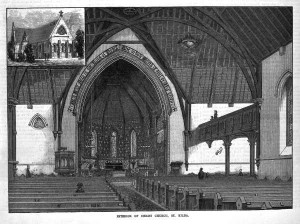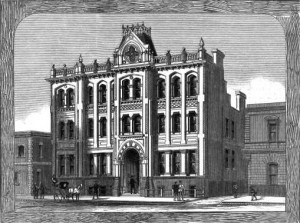A common question we get asked at the Library is where can I find information about a particular person?
The process of researching just one man, Albert Purchas, illustrates how information can be found in a surprising variety of publications, including books, newspapers, government publications and online.
Albert Purchas (1825-1909) was a Melbourne architect, surveyor, inventor and officer in the Victorian volunteer army. He came to Melbourne from England in 1851 and by 1853 had designed the Melbourne General Cemetery. It was the first cemetery in Victoria to be designed in a park style, with wide paths, gate lodges, rotundas, chapels and gardens. He also served as the Cemetery’s secretary for many years.
The encyclopedia of Australian architecture tells me he joined his brother-in law Charles R Swyer in the partnership Purchas & Swyer, designing many banks, mostly in the Renaissance Revival style. They were also responsible for the Christ Church of St Kilda, St. John’s Anglican Church, Heidelberg and Glenara Homestead, Bulla. Amongst many other buildings, Purchas later designed the barristers’ chambers in Little Collins street. Our illustrations of the building (below) are taken from The Australasian sketcher newspaper.
Interior of Christ Church, St Kilda, A/S01/07/82/196
The barristers’ chambers, Little Collins street and Bourke-street west, A/S28/01/82/20
In the Victoria Government Gazette, I found a number of notices advising of Purchas’ appointments in the Victorian Volunteer Force. He was a member of the Royal Victoria Yeomanry Corps and went on to become Captain in the Victorian Volunteer Force and Officer Commanding the Metropolitan Troop of the Prince of Wales Light Horse.
Victoria government gazette, September 22, 1865, p.2165
[Volunteer review, Melbourne Racecourse, Easter Monday], H93.166/27B
Newspapers often contain personal notices such as obituaries, marriage notices and letters which can tell you more about a person’s interests. As an architect, Purchas was well aware of the dangers of fire in wooden interiors, as this letter to The Argus attests. He took out a patent, with fellow architect Alfred Smith, for an invention to fire-proof floors, arches, staircases and other parts of buildings (see Victoria government gazette, 14 September, 1883, p.2118 patent number 3522).
He also applied for a patent for an invention for lighting a railway carriage with gas, which appears in the Victoria government gazette, 2 August, 1861, p.1484, patent number 479 (below).
Illustration from Victorian patents, MF 367
As a prominent Victorian, Purchas was always interested in public matters and wrote to the newspaper on issues of concern, such as the city’s drainage. In an 1896 article titled Major Purchas fined, The Argus reported that Purchas, then 71, was taken to court for refusing to show his ticket at Princes Bridge station and in a show of temper, he hit the ticket collector with his walking stick.
You can read, online, Purchas’ Book of reference to Map of the settled districts around Melbourne, in the colony of Victoria, and view images of many of the buildings he designed. More information on his buildings, such as the St George’s Uniting Church, can be found by searching the Victorian Heritage Database.
The Library holds an abundance of architectural resources, including the Records of the Victorian Chapter of the Royal Australian Institute of Architects So remember when researching a person, think broadly and be prepared to search across a number of formats because information might be there, just well hidden!
Written by Barbara Carswell
Librarian, Redmond Barry Team
and
Paul Dee
Librarian, Australian History and Literature Team




![[Volunteer review, Melbourne Racecourse, Easter Monday] A wood engraving from 1862 showing the Victorian Volunteer Army](https://blogs.slv.vic.gov.au/wp-content/uploads/2013/05/VOLUNTEERB-300x198.jpg)

